“Under the step, toward the right, I saw a small iridescent sphere of almost unbearable brightness. At first I thought it was spinning; then I realized that the movement was an illusion produced by the dizzying spectacles inside it. The Aleph was probably two or three centimeters in diameter, but universal space was contained inside it, with no diminution in size. Each thing (the glass surface of a mirror, let us say) was infinite things, because I could clearly see it from every point in the cosmos. I saw the populous sea, saw dawn and dusk, saw the multitudes of the Americas, saw a silvery spiderweb at the center of a black pyramid, saw a broken labyrinth (it was London), saw endless eyes, all very close, studying themselves in me as though in a mirror, saw all the mirrors on the planet (and none of them reflecting me), saw in a rear courtyard on Calle Soler the same tiles I’d seen twenty years before in the entryway of a house in Fray Bentos, saw dusters of grapes, snow, tobacco, veins of metal, water vapor, saw convex equatorial deserts and their every grain of sand, saw a woman in Inverness whom I shall never forget, saw her violent hair, her haughty body, saw a cancer in her breast, saw a circle of dry soil within a sidewalk where there had once been a tree, saw a country house in Adrogué, saw a copy of the first English translation of Pliny (Philemon Holland’s), saw every letter of every page at once (as a boy, I would be astounded that the letters in a closed book didn’t get all scrambled up together overnight), saw simultaneous night and day, saw a sunset in Querétaro that seemed to reflect the color of a rose in Bengal, saw my bedroom (with no one in it), saw in a study in Alkmaar a globe of the terraqueous world placed between two mirrors that multiplied it endlessly, saw horses with wind-whipped manes on a beach in the Caspian Sea at dawn, saw the delicate bones of a hand, saw the survivors of a battle sending postcards, saw a Tarot card in a shopwindow in Mirzapur, saw the oblique shadows of ferns on the floor of a greenhouse, saw tigers, pistons, bisons, tides, and armies, saw all the ants on earth, saw a Persian astrolabe, saw in a desk drawer (and the handwriting made me tremble) obscene, incredible, detailed letters that Beatriz had sent Carlos Argentino, saw a beloved monument in Chacarita, saw the horrendous remains of what had once, deliciously, been Beatriz Viterbo, saw the circulation of my dark blood, saw the cods and springs of love and the alterations of death, saw the Aleph from everywhere at once, saw the earth in the Aleph, and the Aleph once more in the earth and the earth in the Aleph, saw my face and my viscera, saw your face, and I felt dizzy, and I wept, because my eyes had seen that secret, hypothetical object whose name has been usurped by men but which no man has ever truly looked upon: the inconceivable universe.”
– Jose Luis Borges, Author, The Aleph
Adrogué – One of the things I’d been told not to miss on my visit to this town, is it’s array of plazas. A simple pattern of six, connected by a network of streets that includes diagonals – a pattern of byways that the same city designers later used on a larger scale for the center of La Plata, the provincial capital. The pattern of six was important – it was the number of ships in the fleet of Almirante Brown, the naval leader for whom the partido is named, and, the plazas are not only laid out in his fleet’s sailing pattern, but each of them is named after the commander of the vessel in that position – or so the legend goes. It was a simple enough walk, and gives a nice flavor of this central part of town – immediately notable that virtually every home is behind gates, regardless of location or size. A hold over, perhaps, from the days when Adrogué was the weekend spot for the Buenos Aires gentry, 1872-1920, roughly.
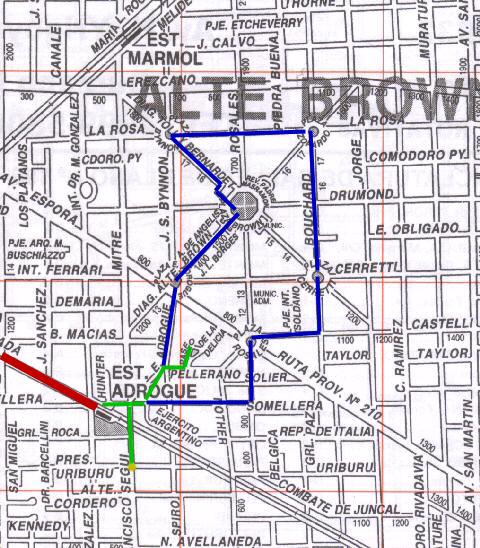
From my empanada adventure in the previous post, I headed back to the center of town and embarked on this little jaunt – following the blue line on the map, and first up, Plaza Rosales. A very plain round, in a fairly heavily trafficked commercial area, a ring of six trees in the center, and facing onto the main diagonal, a map set in ceramic tile of the town’s principal routes.
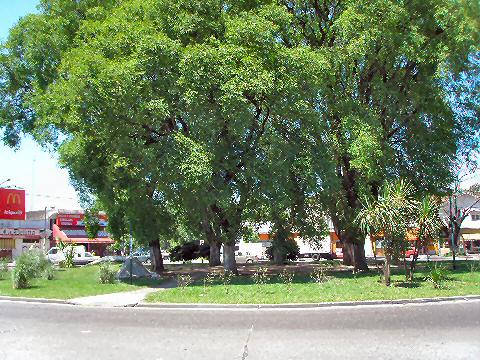
A short walk along a tree-lined street, set with small ranch style homes, mostly of fairly modern brick, which would lead me to believe that many of them have been redone over the last couple of decades, and I arrived at Plaza Cerretti. Here, cobblestones line the street, the trees are somehow darker, larger, almost, strangely, a touch foreboding. A pizzeria, with a half dozen folk gazing at the plaza sits to one side, a young couple necks on a bench under the trees, a young man catches some sun in one of the few non-shaded patches.
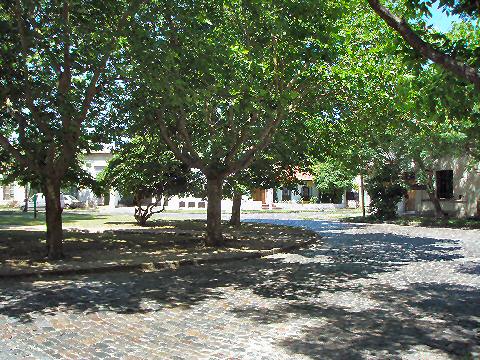
As I walk along Bouchard, the homes are suddenly larger, mansions really – and many, including this one, behind a stone wall with small inset fences where one can glimpse the grounds, are for sale. In fact, much of Adrogué’s real estate seems to be for sale, I think every block I walked on had anywhere from one to three real estate signs posted along the way.
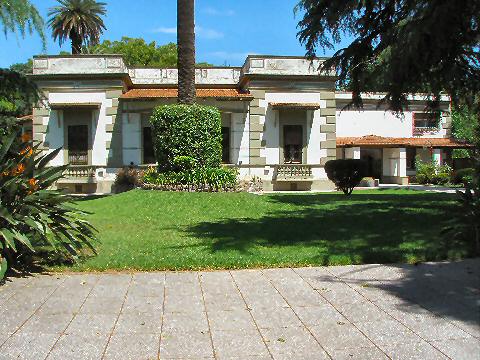
I reach Plaza Azopardo, a sparse, somewhat weedy and vaguely unkempt spot, one of the few places I see on my walk that doesn’t seem well cared for. Not that it’s rundown, it’s more… rumpled, like it has just awoken and thrown on a few trees and bushes in order to answer the door.
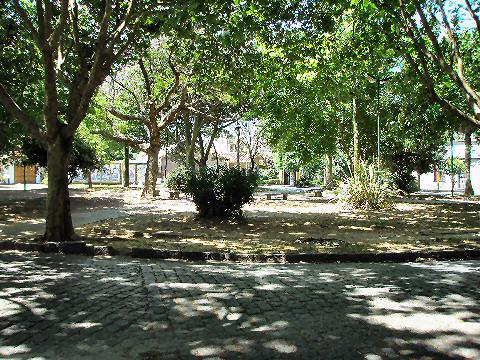
Turning now, and heading along La Rosa, the homes are more modest, but numerous small institutes seem to have taken over their care, and I see schools and study centers of various sorts. It’s a longer, nearly unbroken stretch, but shortly I find myself at Plaza Bynnon, where a large brick archway with a wind mobile of angels mounted above it greets those entering the heavily wooded round.
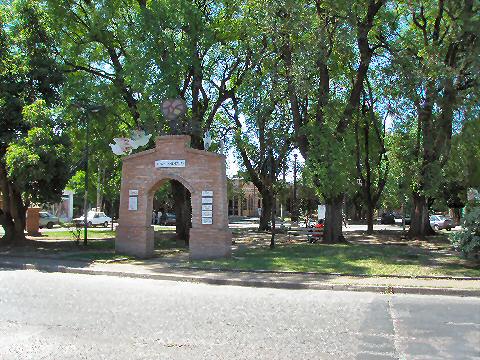
And, heading into the center of the formation, I very quickly reach the central town “square”, with it’s high statue of Almirante Brown himself, looking out across the waves as his fleet heads forward. Here, children play, people are catching sun, a clear gathering place for much of the town, and off to one side is a large elementary school, which appears as if it may be the principal one for the town.
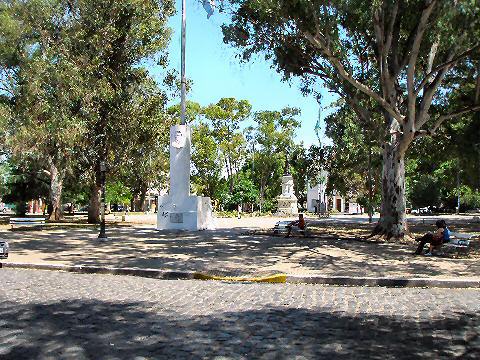
And then heading down the main commercial diagonal, back towards the downtown area, I reach the last of the hex, Plaza Adrogué itself – and why I say above that the names of the plazas are a legend, because nothing I’ve uncovered indicates that Adrogué himself was a naval commander of any sort, but a civilian merchant for his entire career, amassing quite a fortune, still, perhaps I just haven’t seen anything documented.
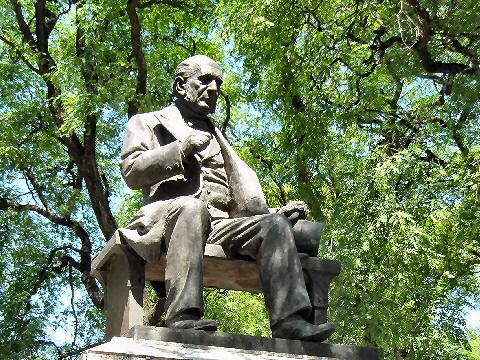
Not that this walk was tiring, taking up a mere hour or so, but had this playground of a sushi bar been open for an afternoon snack on my way back, I might have stopped in for a bite at poolside… this is still clearly a town with an edge of wealth about it.
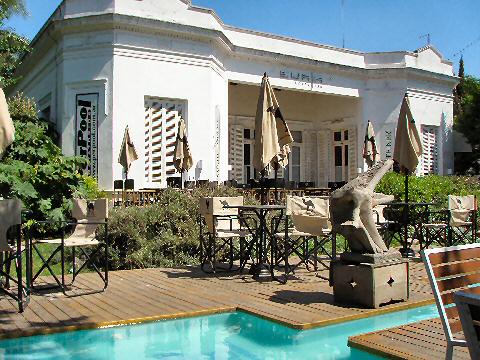
Instead, I head back to the train station and the capital.